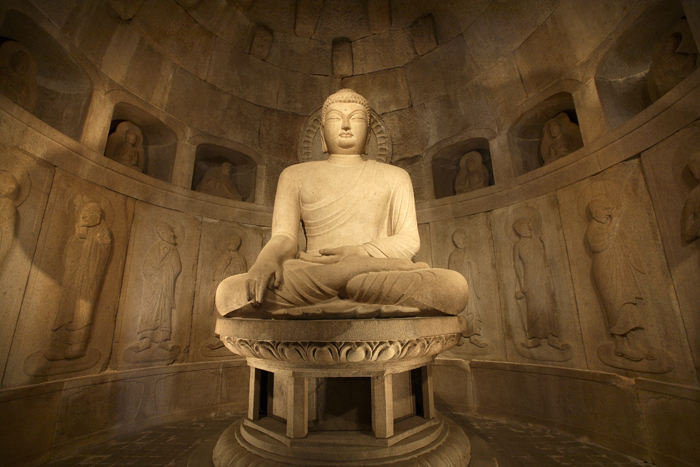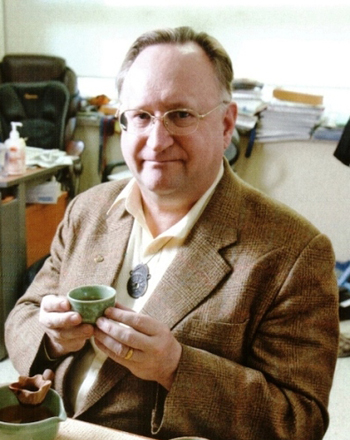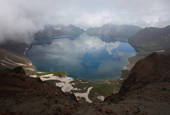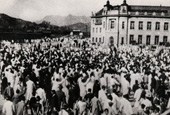Around a decade ago, I was guiding an academic excursion for the Royal Asiatic Society to Korea's ancient capital of Gyeongju. One of the members was a wealthy American who had traveled to most of the countries around the world, but this was his first visit to Korea. He was a Buddhist who had already visited all the other great Buddhist artworks throughout Asia. When we walked into the antechamber of the Seokguram Grotto, he just stood there in silent amazement while crowds of other tourists passed behind us. When we finally exited, he was still silent and introspective for a minute, and then turned to me with a quizzical look, asking, “Why haven't I known about this before? That's one of the best pieces of Buddhist artwork in the world!” I could only reply that this was a fairly common situation for this nation, whose attractions and treasures are generally less well known than they deserve to be, especially this one.
The Seokguram Grotto is one of Korea’s greatest tangible national treasures and is finally now becoming famous around the world as one of the most supreme pieces of global Buddhist art. It is part of the hermitage at Bulguksa Temple, designed as a Buddhist cave-shrine at the end of an era that saw many other famous ones made in the previous 1000 years in India, Central Asia and China. Koreans only made a few of these, and this one is supreme. They rarely used natural or dug-out caves to make Buddhist shrines, as in other nations, but built this one as a grotto using stone blocks.
It is perched just east of Bulguksa Temple, up near the peak of Tohamsan Mountain, facing east at more than 750 meters above sea level, within the Gyeongju National Park. You can take a bus, taxi or car up there from Bulguksa Temple, which takes about 20 minutes, or hike up the 4-kilometer trail in about one hour.

Seokguram was built along with the temple during the reigns of kings Gyeongdeok (r. 742-765) and Hyegong (r. 765-780) of the Silla Kingdom, under the inspiration and direction of Prime Minister Kim Dae-seong. It was constructed between 742 when he resigned from court and 774, shortly after his death.
This man-made grotto was assembled from hundreds of pieces of white granite of various shapes and sizes. Facing the East Sea down a long valley through the coastal mountain ridges, the Seokguram Grotto stands as a proud testimony to Korea's brilliant tradition of classical Buddhist sculpture. Its walls display a noble pantheon of divinities symbolizing Buddhist philosophy and aesthetics. It is a structure of sublime beauty embodying religious belief, science and the fine craftsmanship which flowered in that golden age of Asian art. This stone sanctuary is a unique landmark of world religious art, the quintessence of the fine arts of the Silla Kingdom, and an unrivalled masterpiece in respect to the numerous majestic carved figures with their realistic expressions and unique features.
Its grandeur has been cited by some scholars as evidence of the increasing acceptance of Buddhism as a ruling ideology at the time. According to legend, Kim Dae-seong constructed it to honor his parents from his previous lifetime. However, some details, in particular the placement of the central Buddha statue which gazes precisely in the direction of the underwater tomb of King Munmu (r. 661-681), the first ruler of the Unified Silla, and the sunrise at the winter solstice, suggest that the temple may have been built to glorify the king or the royal line instead.

The Seokguram Grotto itself consists of a perfect golden-mean rectangular antechamber, symbolizing the earth, a corridor symbolizing the conduit between earth and the heavens, and a main rotunda with a domed ceiling representing the Buddhist heaven. The 9-meter rotunda centers on the main statue of a seated Sakyamuni Buddha. It is about 3.5 meters tall and sits on a lotus flower-shaped pedestal more than a meter in height, the largest free-standing stone Buddha statue ever made in pre-modern Korea and one of the most beautiful and impressive in the world. The grotto was constructed so that the rays of the rising sun fall on it and by reflection softly illuminate the holy figures surrounding him: bodhisattvas, disciples and gods embodying various aspects of Buddhist teachings. This majestic Buddha sports a powerful torso and chest, giving the impression of strength and stability, but wears a serene, all-knowing expression of deep self-concentration and benevolence.
Hidden behind this main figure, intended only for the eyes of the elite allowed to conduct their circumambulations here, is a statue of the eleven-headed form of Gwanseeumbosal, or Avalokitesvara, the Bodhisattva of Compassion, famous for its exquisite beauty and thought to be the single best bas-relief carving ever made in traditional Korea.
All of it is carved from fine white granite and shows an impeccable level of skill and artistry, the zenith of what Asians achieved through stone sculpture. The grotto chapel, in spite of the diversity of icons ensconced, has a unique feeling of peace and unity, emitting an intense spiritual energy that never fails to impress visitors such as my wealthy friend.
The Seokguram Grotto is now designated as National Treasure No. 24 and was listed, together with Bulguksa Temple, as Korea’s first UNESCO World Heritage Site in 1995. It remains perennially one of the nation’s top tourist attractions, an object of scholarly study and a pilgrimage destination. It is one of the greatest tangible Buddhist cultural treasures of the world.
By David A. Mason
A Professor of Korean Cultural Tourism at Nam-Seoul University
Discover Korea with the RAS
[The Royal Asiatic Society Korea Branch, founded in 1900, is an association of people, Koreans and non-Koreans alike, who wish to deepen their knowledge of Korean life, culture and history, and share that knowledge with others in English. http://www.raskb.com/ ]

The Seokguram Grotto is one of Korea’s greatest tangible national treasures and is finally now becoming famous around the world as one of the most supreme pieces of global Buddhist art. It is part of the hermitage at Bulguksa Temple, designed as a Buddhist cave-shrine at the end of an era that saw many other famous ones made in the previous 1000 years in India, Central Asia and China. Koreans only made a few of these, and this one is supreme. They rarely used natural or dug-out caves to make Buddhist shrines, as in other nations, but built this one as a grotto using stone blocks.
It is perched just east of Bulguksa Temple, up near the peak of Tohamsan Mountain, facing east at more than 750 meters above sea level, within the Gyeongju National Park. You can take a bus, taxi or car up there from Bulguksa Temple, which takes about 20 minutes, or hike up the 4-kilometer trail in about one hour.

Seokguram Grotto in Gyeongju, National Treasure No. 24, is the most famous Buddhist hermitage in Korea. (Photo: Yonhap News)
Seokguram was built along with the temple during the reigns of kings Gyeongdeok (r. 742-765) and Hyegong (r. 765-780) of the Silla Kingdom, under the inspiration and direction of Prime Minister Kim Dae-seong. It was constructed between 742 when he resigned from court and 774, shortly after his death.
This man-made grotto was assembled from hundreds of pieces of white granite of various shapes and sizes. Facing the East Sea down a long valley through the coastal mountain ridges, the Seokguram Grotto stands as a proud testimony to Korea's brilliant tradition of classical Buddhist sculpture. Its walls display a noble pantheon of divinities symbolizing Buddhist philosophy and aesthetics. It is a structure of sublime beauty embodying religious belief, science and the fine craftsmanship which flowered in that golden age of Asian art. This stone sanctuary is a unique landmark of world religious art, the quintessence of the fine arts of the Silla Kingdom, and an unrivalled masterpiece in respect to the numerous majestic carved figures with their realistic expressions and unique features.
Its grandeur has been cited by some scholars as evidence of the increasing acceptance of Buddhism as a ruling ideology at the time. According to legend, Kim Dae-seong constructed it to honor his parents from his previous lifetime. However, some details, in particular the placement of the central Buddha statue which gazes precisely in the direction of the underwater tomb of King Munmu (r. 661-681), the first ruler of the Unified Silla, and the sunrise at the winter solstice, suggest that the temple may have been built to glorify the king or the royal line instead.

Professor David A. Mason
The Seokguram Grotto itself consists of a perfect golden-mean rectangular antechamber, symbolizing the earth, a corridor symbolizing the conduit between earth and the heavens, and a main rotunda with a domed ceiling representing the Buddhist heaven. The 9-meter rotunda centers on the main statue of a seated Sakyamuni Buddha. It is about 3.5 meters tall and sits on a lotus flower-shaped pedestal more than a meter in height, the largest free-standing stone Buddha statue ever made in pre-modern Korea and one of the most beautiful and impressive in the world. The grotto was constructed so that the rays of the rising sun fall on it and by reflection softly illuminate the holy figures surrounding him: bodhisattvas, disciples and gods embodying various aspects of Buddhist teachings. This majestic Buddha sports a powerful torso and chest, giving the impression of strength and stability, but wears a serene, all-knowing expression of deep self-concentration and benevolence.
Hidden behind this main figure, intended only for the eyes of the elite allowed to conduct their circumambulations here, is a statue of the eleven-headed form of Gwanseeumbosal, or Avalokitesvara, the Bodhisattva of Compassion, famous for its exquisite beauty and thought to be the single best bas-relief carving ever made in traditional Korea.
All of it is carved from fine white granite and shows an impeccable level of skill and artistry, the zenith of what Asians achieved through stone sculpture. The grotto chapel, in spite of the diversity of icons ensconced, has a unique feeling of peace and unity, emitting an intense spiritual energy that never fails to impress visitors such as my wealthy friend.
The Seokguram Grotto is now designated as National Treasure No. 24 and was listed, together with Bulguksa Temple, as Korea’s first UNESCO World Heritage Site in 1995. It remains perennially one of the nation’s top tourist attractions, an object of scholarly study and a pilgrimage destination. It is one of the greatest tangible Buddhist cultural treasures of the world.
By David A. Mason
A Professor of Korean Cultural Tourism at Nam-Seoul University
Discover Korea with the RAS
[The Royal Asiatic Society Korea Branch, founded in 1900, is an association of people, Koreans and non-Koreans alike, who wish to deepen their knowledge of Korean life, culture and history, and share that knowledge with others in English. http://www.raskb.com/ ]


